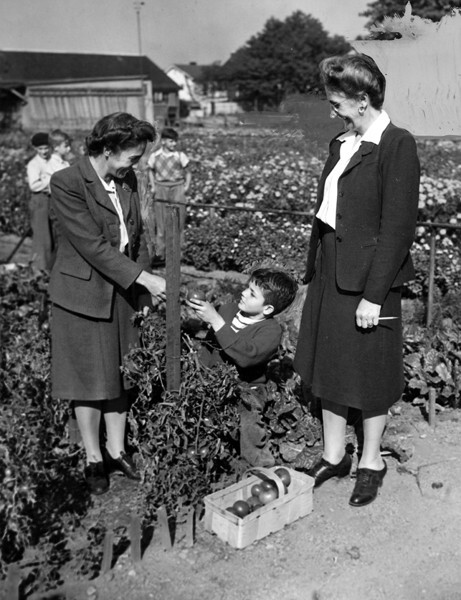
The Cleveland public school garden program was the most successful—and most emulated—garden program in the United States. Horticultural educators came from all over the country, and sometimes from other countries, to learn how to adapt the program into their cities.
In 1904, the Cleveland Public Schools began a small school gardening program as a way to beautify vacant lots. The idea quickly spread throughout the city, expanding to become a multimillion dollar education program that served 20,000 students at its peak. Generations of schoolchildren, beginning in kindergarten and continuing through the 12th grade, participated by growing food, beautifying vacant lots, and learning about the science of gardening. School gardens could be as small as a plot of land on a vacant lot or as large as a small farm with acres of land.
The larger gardens were called tract gardens and were the gems of the program, being considered as visual proof of the program's success. Garden science and horticulture became a part of the schools’ curriculum, generally with the science teacher becoming the garden teacher as well. In the second half of the 20th century, Cleveland set up a vocational horticulture program for older students, which prepared them for work and college in the fields of horticulture and earth science. If the students met the necessary prerequisites the possible programs they could enroll in were Environmental Management, Agriculture Mechanics, Ornamental Horticulture, or Small Animal Care.
Because most teachers had a limited background in horticulture, the classes were often coordinated with a radio program that was set up by the Board of Education. The materials used in the broadcast—items like guidebooks, seeds, and tools—were sent to the teacher before the broadcast. The classes often took place at the same time as the broadcast so the students could follow along. These were likely the first radio-driven horticultural lessons in the nation.
Of all of the Cleveland school gardens, the one at Benjamin Franklin Elementary School is notable today for being the oldest and largest surviving community garden in Greater Cleveland. Located in the Old Brooklyn neighborhood, the 5.5-acre Benjamin Elementary School garden was once the second in size after the 7-acre Harvey Rice School Garden in the old Slovak-Hungarian neighborhood of Woodhill and Buckeye Roads.
In 1922 the Board of Education bought eleven acres of land from the owner of Boyert Farm, which was one of a number of large greenhouse operators in the vicinity of Brooklyn in the early 20th century. The land was then divided in half, one half for the school and the other for the garden. At first the garden was used as a nursery to grow plants to help beautify the area. After the school was completed in 1923 the students and others in the area were encouraged to rent individual plots. Plots were rented to children from grades 3 through 12, but there were plots for kindergarten through 2nd grade classes as well. The rental fee for plots not only covered the cost for the land, but also paid for the seeds, plants, fertilizer, and tools. The plots were typically 6 feet by 10 feet for third graders, and could get up to 10 feet by 30 feet for high school students.
Karl J. Koop, the first superintendent of Benjamin Franklin, contributed much to the development and expansion of the tract garden program, not only in Cleveland, but in other cities looking to copy the program as well. Many of the techniques and programs that he implemented, such as the design and layout of a tract garden as well as the recycling of vegetation and composting, continued to be used through the 1970s.
The Cleveland garden program, whose mantra was “Children Grow in Gardens,” came to an end in the fall of 1977. Unfortunately the small rental fee the children paid to rent the plots was never enough to cover the costs of the program. The main reason for ending the program was a growing budget deficit in the schools, and with less money one of the first programs to be cut was the school garden program.
The Benjamin Franklin Garden still exists today. However, it is a community garden rather than a school garden, and its size has been reduced somewhat to 5 acres from the original 5.5 acres. Despite its reduced size, it remains one of the largest, if not the largest, community gardens in the state. The current garden was established through an agreement between the Old Brooklyn CDC (Community Development Corporation) and the Cleveland Board of Education. There are currently over 200 plots and an average of 180 gardeners per year. The garden is run with help from staff from the Ohio State University Extension program who assist the gardeners with their plots. The OSU Extension and the City of Cleveland’s Summer Sprout program also provide seeds and plants for gardeners. In a survey of the area, the three things that Old Brooklyners love about their neighborhood are the Zoo, the monthly paper, and the Ben Franklin Garden. If the community were to have their way, the land will continue to be a gardening space for decades to come.
Images






